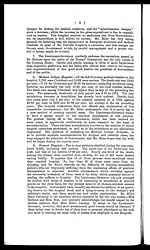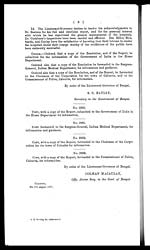Medicine - Institutions > Reports from medical colleges, schools and research institutions > Report on the Calcutta medical institutions > Calcutta medical institutions reports 1871-78 > Report on the Calcutta Medical Institutions for the year 1876
(574) Page 5
Download files
Individual page:
Thumbnail gallery: Grid view | List view

( 5 )
10. Campbell Hospital.—It has already been observed that the admissions
to this hospital were 1,147 less in 1876 than in 1875. The death-rate, though
still remarkably high, shows a satisfactory decrease from 280 per mille in 1875
to 250. Excluding moribund cases, the mortality was 224 for each thousand
treated. It is of course unavoidable that a great proportion of the pauper
patients in this hospital should die; and the statement of the prevalent diseases
shows that more than three-fourths of the total mortality resulted from ailments
chiefly occasioned by malarious poisoning and exposure, aggravated by poverty.
The monthly cost per patient has risen from Rs. 16-13 in 1875 to Rs. 17-2-10 in
1876. The excessive expenditure in this hospital has already been adverted to,
and is forming the subject of enquiry by a special Committee.
11. Mayo and Chandney Hospitals—These hospitals, with their affiliated
dispensaries, continue to afford medical aid to the vast bulk of native patients.
In all 189,690 persons received treatment at them during the year. The
decrease of 4,075, which these figures show on the returns for 1875, is entirely
due to a falling off in the attendance of out-door patients at the dispensaries
and at the Chandney Hospital. The returns of the out-door patients treated at
the Mayo Hospital itself show an increase of 2,079; but those of Park Street
and Chitpore Dispensaries exhibit a falling off of 1,797 and 3,561 respectively.
This is one of the most unsatisfactory features in the year's report, but no
explanation has been offered regarding it. The mortality at these institutions
was 127 per mille in 1876, against 117 in 1875. Dr. Beatson has drawn atten-
tion to some remarkable divergences in the death-rate from the same diseases
at the Mayo and the Chandney Hospitals. This difference has not been explained
by the Superintendent, and, as Dr. Beatson remarks, it is the more notice-
able, because it may be presumed that the patients in both cases came from
the same class of the population.
12. Howrah Hospital.—This hospital, with limited funds and accommoda-
tion, does much to meet a really serious want, and its increasing popularity and
usefulness are highly creditable to Dr. Bird. The past year has seen an increase
among all classes of patients, in-door as well as out-door, Christian as well
as native. The utmost possible use has been made of available accommodation,
and at times the verandahs have been used as wards. The mortality among the
Christian and native patients was widely divergent, being only 34 per mille
among the former and no less than 218 per mille among the latter. The
death-rate was particularly high among native females, 275 among Mussulmans,
and 286 among Hindoos. There was a slight decrease in the number of cases
of cholera treated; but the disease was of a specially virulent character among
the native patients, producing a death-rate of 564 per mille, against 254 in the
previous year. Phthisis contributed the high death-rate of 555 per mille.
Remittent fever was also of a severe type. Dr. Bird reports very favourably
on Warburgh's tincture as a specific for this disease. He says that, "with
abundance of this drug at hand, the medical man may confidently count on a
successful result in almost every case, provided the patient comes under his
care not later than the seventh day of the fever." The remarks of the Magis-
trate of Howrah on the admirable service rendered by Dr. Bird in connection
with this hospital, which owes its establishment and success to his personal
exertions, have Mr. Eden's full concurrence.
13. Other institutions.—The attention of the Commissioner of Police will
be directed to Dr. Woodford's observations upon the state of debility to which
many of the up-country constables reduce themselves by their parsimonious
habits. No figures of mortality are given for the Sumbhoo Nath Pundit and
Arratoon Apcar Dispensaries. A verandah is much required in the last-named
building for the use of patients waiting for treatment. The death-rate in the
Alipore Dispensary shows a satisfactory decrease from 319 to 136 per mille.
The report on the lock-hospitals has been separately considered.
Set display mode to: Large image | Zoom image | Transcription
Images and transcriptions on this page, including medium image downloads, may be used under the Creative Commons Attribution 4.0 International Licence unless otherwise stated. ![]()
| Permanent URL | https://digital.nls.uk/74974610 |
|---|
| Description | 13 titles. Describes research work and conditions, treatments, vaccine production, medical education, public health and disease outbreaks. Extensive tables show mortality rates and patient admissions. These - some from asylums, jails, dispensaries, civil and police hospitals – will be useful to epidemiologists. |
|---|




